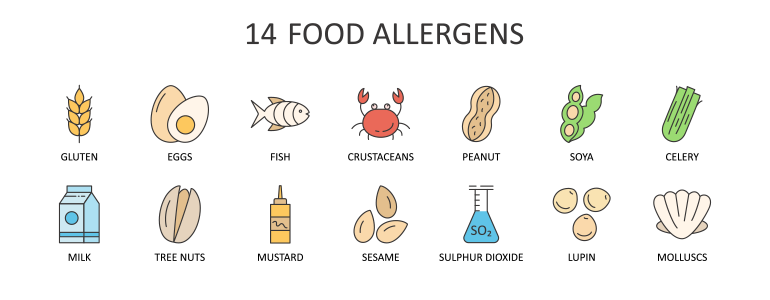In the UK, food anaphylaxis admissions have increased from 1.23 to 4.04 per 100,000 population per year between 1998 and 2018. The largest increase in hospital admissions was children under 15 years, which went from 2.1 to 9.2 per 100,000 population per year (Conrado et al., 2021). As there is not currently a cure for food allergies the only option is avoidance. Allergy sufferers are putting their trust in food businesses to take every precaution to help keep them safe.
There are 14 ingredients recognised to be allergens by the UK government. The Food Standards Agency (FSA) manages and monitors standards concerning food safety, which includes enforcing laws such as Natasha’s Law that came into force October 2021. Natasha’s Law is the most recent labelling standards focusing on prepacked for direct sale (PPDS) food products. It was a result of heavy campaigning from Natasha Ednan-Laperouse parents following the death of Natasha at 15 years old after consuming a baguette with traces of sesame, which she was allergic to.
From the point of receiving raw materials, you’re responsible for ensuring that legal regulations are met; however, it is a good idea to have even higher internal standards within your company.

What is Allergen Management?
Whether you are creating a food product from scratch, just an element, or if you’re part of the manufacturing supply chain, you are required to protect the ingredients or product; this also includes allergen contamination.
Allergen Management is a system of policies and procedures that serves to identify, control, educate, and acts as due diligence surrounding handling, storing and transporting allergens in your business, from raw materials to finished products. An allergen management program should be developed and amended as things change within the business. This should not be a document that sits on a shelf but should be lived by and implemented on a daily basis.
Ways to manage allergen in food manufacturing
Critical control points (or CCPs) surrounding allergies, should be in place by all food-related businesses. Below highlights the areas that are specific to food manufacturing.
Supplier transparency and documentation
Transparency throughout the supply chain is becoming an expected and also critical for a business’s ethical responsibility. Reducing the supply chain length as much as possible and only using trusted suppliers who can verify the allergy status of anything supplied will help control and protect the product and your company’s reputation. Ensure that you are keeping adequate traceability reports in order to comply with food traceability regulations.
Supplier certification
You may wish to require suppliers to hold a BRC or SALSA certification to give you extra reassurance that processes are in place to prevent cross-contamination. A BRC certification will mean the company is being inspected annually by the certification body to check that they have the following in place and adhering to best practices:
- Procedures in place to control allergens to help prevent cross-contamination
- Identification of allergen risk at each step of the production
- Clear acceptable and unacceptable cleaning levels
- List of allergan products handled on-site at any given time
- Equipment and systems to prevent allergies particles moving through the air
Food Manufacturing Production
- Wherever possible, avoid using the UK’s 14 allergens (celery, gluten, crustaceans, eggs, fish, lupin, milk, molluscs, mustard, peanuts, sesame, soybeans, sulphur dioxide, and sulphites, and tree nuts). If they are used, ingredients must be recorded on product specification sheets.
- Ideally, there would be two separate production lines, one for products containing allergies and one for products that do not. However, unfortunately, this is not always possible, so scheduling becomes critical for risk management. Grouping production of allergy products and allowing adequate time for extensive cleaning to be carried out between allergy and non-allergy production runs must be scheduled into production planning to help prevent cross-contamination.
- During production, allergen components should be introduced into the process as late as possible.
- A well-organised and thought-out designed manufacturing site can make all the difference. Plenty of space between manufacturing lines, air handling systems, and physical screens between production lines can help prevent cross-contamination through the air.
- Ensure that your business has processes in place in the event of a product recall or redrawal. Discover product redrawal and recall best practices and how food traceability record keeping plays a vital role. According to Food Manufacture, allergies continue to be the main cause of food and drink recalls in the UK. Between 2008 and 2018, 2932 food safety incidents and recalls were reported globally, 46% of them were due to undeclared food allergens (Soon et al., 2020). This is why allergy management in the food manufacturing sector is top of food safety agendas globally.

Storage and handling
If an allergen ingredient is included in the manufacturing of a product, dedicated preparation area and equipment should be used; including staff protective wear such as gloves to help control the risk of cross contamination.
Allergy ingredients should be stored in a dedicated area away from other ingredients. If this is not possible, then allergy products should be stored in well sealed containers and located on a shelf below other ingredients; to prevent fragments contaminating other goods.
Allergy Training
Building a food safety culture within your company should be of the highest importance; to protect your business, supplier relationships and consumers. After all, employees are the ones on the front line day in and day out, and their actions or lack of care can have huge knock-on effects on your business.
Processes should be clearly communicated to staff, laying out company expectations such as protective clothing, handwashing, and handling systems. This should not only be covered in introduction training but repeated regularly, with particular attention given to risk areas such as managing allergy goods. It may be beneficial to provide staff with external allergy training, such as Highfield’s online allergy training course.
Everyone in the food industry has an ethical responsibility to recognise the seriousness of food allergies; and how they play a role in implementing allergen management systems to protect consumers.
Cleaning
Cleaning is the most vital element in allergy risk management. Stringent sanitation processes should be carried out before, during, and after production runs containing allergen products.
- Using products such as Hygiena allergen testing swabs will help validate the effectiveness of the cleaning processes and should be used in conjunction with an antibody-specific test.
- Don’t forget to check that the team is focusing on hard-to-clean areas.
Allergy Labelling
Product documentation should follow the product through the supply chain to verify allergy status. Food manufacturers should ensure that UK legal labelling requirements are met, giving adequate warning of any included allergen ingredients for all finished ready-for-consumption products. If a product is being sold outside the UK, ensure that you meet legal requirements for the given country.
Staff should be trained to double check products and review product documentation regularly before placing labelling. Barcode scanners can help to automate this process. However, it is still important for the relevant product team to manually review formulations and packaging at least once a year.
Formulation changes
Ingredient changes will inevitably take place. Where possible, it’s best to avoid introducing known allergy ingredients. If this is not possible it should be managed and communicated with great care. Ingredient changes should be well documented and communicated between relevant business functions to ensure changes are implemented correctly to prevent miss labelling. Suppliers should be informed of any formulation changes.


